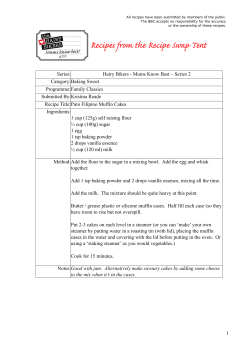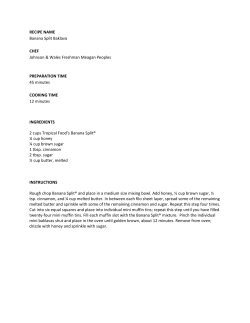
Unit 10 Supplement: How to Use the CBL - 2
Supplementary Curriculum JS Galinski How to Use the CBL – 2 Page 1 of 3 Unit 10 Supplement: How to Use the CBL - 2 Some of the labs that you will do during advanced high school chemistry courses (and many of the labs you will do in college chemistry courses) will require you to use computerized data collection, so it is important that you are exposed to it at this early date. To that end, this document contains the second of several very simple CBL laboratory activities that you must perform for this class. This CBL laboratory activity requires a complete written report in your lab journal, which is due on the day of the Unit 10 exam. Again, the CBL activities that are required of you during first semester are designed to give you a preview of some of the topics that will be delved into more deeply in later units during this school year. It is hoped that these activities will jump-start your thinking and prepare you for some of the topics you will be covering during second semester. You might want to refer to the document containing the earlier CBL lab writeup if you have forgotten how to setup the CBL for data collection. Laboratory Activity CBL – 02: Investigate a Colligative Property You should create a complete Lab Report for this Laboratory Activity. The physical properties of a solution differ from those of the pure solvent used to make the solution. Some of these differences are due to the mere presence of solute particles in the solution, rather than to the specific identity of the solute. Such properties, which depend only on the number of particles dissolved in a given mass of solvent, are called colligative properties. One important colligative property of solutions is freezing-point depression. When a substance freezes, the particles of the solid take on an orderly pattern. The presence of a solute in water disrupts the formation of this pattern because of the shells of water of a process known as solvation. As a result, more kinetic energy must be withdrawn from a solution than from pure solvent for it to solidify. The freezing point depression is the difference in temperature between the freezing point of a solution and that of pure solvent. You take advantage of the freezing-point depression of aqueous solutions when you sprinkle salt on icy sidewalks to make the ice melt. The ice melts and forms a solution with a lower freezing point than that of pure water. Supplementary Curriculum JS Galinski How to Use the CBL – 2 Page 2 of 3 Materials: TI graphing calculator with CBL interface temperature probe 100-mL graduated cylinder electronic balance weighing boat Styrofoam cup lid for Styrofoam cup 250-mL beaker plastic spoon Chemicals: water ice sodium chloride, NaCl Safety Note: The electronic balance is a very delicate and expensive piece of laboratory equipment. It is very important that you handle it carefully. The use of a weighing boat in finding the mass of powdered solid reagents will prevent chemicals from damaging the balance. The use of a lid on top of the Styrofoam cup will prevent liquids from damaging the balance. Please do all that you can to maintain our laboratory equipment. Procedure: 1. Obtain and wear goggles. 2. Turn on the calculator, and run the DataMate software. 3. Plug the temperature probe into Channel 1 of the CBL2 interface. 4. Program the data collection software to collect readings for temperature every 6 seconds, for 50 trials. 5. Using the electronic balance, find the mass of the empty Styrofoam cup with its lid. 6. Fill the graduated cylinder to the top with water. 7. Pour the water into the Styrofoam cup. 8. Add four cubes of ice to the water. 9. Find the mass of the Styrofoam cup and the water. Remember to securely fasten the lid before putting the cup on the electronic balance. 10. Put the Styrofoam cup containing water into a 250-mL beaker. 11. For the next five minutes, periodically stir the ice water mixture with the temperature probe, noting the temperature of the water. 12. Using the electronic balance, find the mass of an empty weighing boat. 13. Fill the weighing boat with three spoonfuls of sodium chloride. 14. Find the mass of the weighing boat and the sodium chloride. 15. Place the temperature probe into the water and leave it in. Wait about one minute for the temperature to equilibrate. Gently stir the ice water with the temperature probe. 16. Begin the data collection with the CBL. The graph should display on the calculator screen. Wait 30 seconds before proceeding to the next step. 17. While stirring the ice water, pour the sodium chloride in the solution. Supplementary Curriculum JS Galinski How to Use the CBL – 2 Page 3 of 3 18. Continue to stir the solution and record any pertinent qualitative data while the CBL collects quantitative data. 19. When the CBL is done collecting data, exit the software, and detach the temperature probe from the CBL2 interface. Thoroughly wash and dry the stainless steel portion of the temperature probe before returning it to the CBL kit. 20. Pour the contents of the Styrofoam cup down the sink. Wash and gently dry the Styrofoam cup before returning it to the lab kit. 21. Use the TI-Graph Link software to transfer the data from the calculator to a PC. Transfer the data to a Microsoft Excel spreadsheet, and generate a data table, and a graph of temperature versus time. Print out the data table and the graph and attach them directly to your written report in your lab journal. In your lab report, you should address the following questions, as well as anything else you feel is relevant. 1. 2. 3. 4. 5. 6. 7. 8. Why is table salt used in most recipes for the production of ice cream? Why does rock salt melt snow? Why does a driveway covered in rock salt stay melted? What does the process of solvation have to do with freezing-point depression? What was the temperature change, ΔT, for the reaction? Was a chemical reaction was taking place? What does NaCl do when you put it in water? You performed this experiment with NaCl. What sort of result might you expect if you did it with CaCl2? What about AlCl3? Why?
© Copyright 2025











